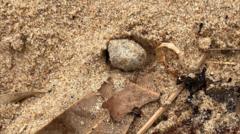The recent influx of mysterious marble-sized balls on Sydney's Northern Beaches has raised significant alarm among local authorities. Originating from the coastline, these debris items were discovered to consist of saturated acids, E. coli, and faecal bacteria, prompting immediate action from health and environmental officials.
On January 14, nine popular beaches, including Manly and Dee Why, were closed to the public as a precautionary measure. These closures occurred months after an earlier appearance of similar black blobs along the coast, which had previously caused temporary shutdowns and extensive cleanup efforts.
The Northern Beaches Council reported that they had forwarded samples of the debris to the New South Wales Environment Protection Authority (EPA) for in-depth analysis. In light of these findings, Mayor Sue Heins expressed hope that the EPA could pinpoint the source of the contamination, aiming to prevent future occurrences on the region's beaches.
Regular inspections of local beaches are being conducted, with authorities encouraging the community to report any sightings of these hazardous materials. In addition to the acids and bacteria, the latest findings indicated that the balls also included volcanic rock pumice.
The previous incident involving the black blobs, initially misidentified as "tar balls," was later revealed to contain a disturbing mix of substances including cooking oil, soap scum, drug residues, and even blood pressure medication. These blobs were likened to "fatbergs," the unpleasant conglomerates often found clogging sewage systems.
Despite concerns, Sydney Water reassured the public that the city’s water treatment plants are functioning properly and that there are no known issues with the waste infrastructure. Safety measures are being reinforced as the community awaits further information from the ongoing investigations into the mysterious beach debris.




















